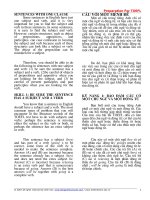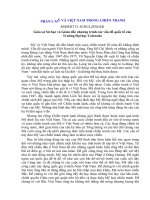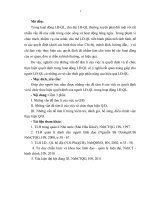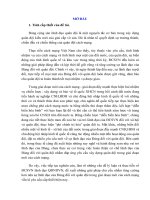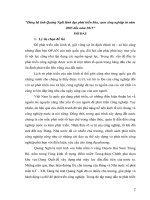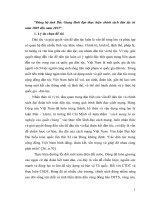Đề thi TOEFL 19
Bạn đang xem bản rút gọn của tài liệu. Xem và tải ngay bản đầy đủ của tài liệu tại đây (179.14 KB, 18 trang )
1
2001 年 1 月 TOEFL 试题
Section One: Listening Comprehension
1. (A) He can have more than four guests at his
graduation.
(B) His brother isn’t going to graduate this
semester.
(C) He didn’t know that Jane wanted to be
invited.
(D) He’s going to invite Jane.
2. (A) Listen to the traffic report on the radio
(B) Take a later train.
(C) Ron to catch the next train.
(D) Check the weekend schedule.
3. (A) Pelivet the notebook to Kathy.
(B) Pind out where Kathy put the notebook.
(C) Ask Kathy to explain the chemistry notes.
(D) Ask Kathy for the man’s notebook.
4. (A) The walk is shorter than the woman thinks it
is.
(B) The lecture has already started.
(C) They won’t have a problem getting seats.
(D) The lecture may be canceled.
5. (A) The woman should have studied French in
Paris.
(B) He didn’t study French in high school.
(C) Living in Paris helped improve the woman’s
language skills.
(D) The woman must have had a good French
teacher.
6. (A) Apologize to his roommate.
(B) Give the notes to the woman.
(C) Call the woman tonight.
(D) Take the woman’s notes to his roommate.
7. (A) She doesn’t have time to talk to Dr. Foster.
(B) She needs the additional time to finish her
paper.
(C) Dr. Foster hasn’t finished grading the
papers.
(D) She wants the man to help her with her
paper.
8. (A) Phone the Cliffside Inn for a reservation.
(B) Ask her parents to come a different
weekend.
(C) Call local hotels again in a few days.
(D) Find a hotel again in a few days.
9. (A) Main her some information about the
conference.
(B) Drive her to the conference.
(C) Attend the conference in her place.
(D) Collect her main while she’s at the
conference.
10. (A)The man should stop by the bookstore on
the way to class.
(B) The man can return the books he doesn’t
need.
(C) The man should have bought his books
earlier.
(D) The man won’t need books on the first day
of class.
11. (A) Help the man with his essay.
(B) Ask Sue to rehearse with her.
(C) Wait to rehearse until the man has finished
his essay.
(D) Meinerize her lines by herself.
2
12. (A) Show her the newspaper that he’s talking
about.
(B) Think about getting an internship at
another place.
(C) Sign up for more than one journalism class.
(D) Call The Times about the internship.
13. (A)He isn’t as good a tennis player as he used
to be.
(B) He hasn’t had time to play tennis recently.
(C) He caught a cold shortly after the
tournament.
(D) He think he’s more important than he is.
14. (A)He’ll graduate before the woman.
(B) He hopes to graduate before the summer.
(C) He doesn’t want to attend school
year-round.
(D) The woman won’t be able to keep up the
pace.
15. (A) It’s too late to buy the morning newspaper.
(B) He doesn’t want to go to the concert.
(C) The box office is closed today.
(D) All of the tickets have been sold.
16. (A) The woman swims as well as he does.
(B) He doesn’t have time to teach the woman
to swim.
(C) He doesn’t enjoy swimming.
(D) He learned to swim at a young age.
17. (A) She has already started working on her
research project.
(B) She can’t decide on a research topic.
(C) She’d like to discuss her research with the
man.
(D) She has to change the subject of her
research.
18. (A) Introduce the woman to his neighbor.
(B) Get a key from his neighbor.
(C) Study in his neighbor’s apartment.
(D) Borrow some books from his neighbor.
19. (A) The man shouldn’t hire the same tutor that
she had.
(B) She isn’t prepared for the midterm exam
either.
(C) It’s too late to find a tutor.
(D) The man should hire a tutor before the
midterm exam
20. (A) Stay in the hotel for at least two nights.
(B) Leave the hotel the next morning.
(C) Ask the hotel clerk for her room key.
(D) Complain to the manager about the extra
charges.
21. (A) He doesn’t recommend going to Central
Mountain.
(B) He doesn’t plan to go skiing during spring
break.
(C) He has never been to Central Mountain.
(D) He isn’t an experienced skier.
22. (A) She knows who the top history student is.
(B) She hasn’t read the campus newspaper
today.
(C) The man is mistaken.
(D) It’s surprising that her roommate likes
history.
23. (A) He’s not qualified to proofread the
woman’s report.
(B) He’ll be able to talk to the woman in a few
minutes.
(C) He hadn’t noticed a lot of the woman’s
mistakes.
(D) He thinks the woman should have asked
him sooner.
24. (A) Practice her presentation in front of him.
(B) Find out who her audience will be
tomorrow.
For more material and information, please visit Tai Lieu Du Hoc at
www.tailieuduhoc.org
3
(C) Try not to think about her audience.
(D) Watch him make his presentation.
25. (A) She’s also curious about who won the
game.
(B) She didn’t go to the game.
(C) She was sitting right behind the man at the
game.
(D) She also left the game early.
26. (A) Make a shopping list.
(B) Buy some groceries.
(C) Finish making the salad.
(D) Wait for the woman to return.
27. (A) He finds the dictionary very useful.
(B) He knows where the woman put the
dictionary.
(C) he doesn’t expect the woman to replace the
dictionary.
(D) The woman should buy her own dictionary.
28. (A) She plans to miss soccer practice.
(B) She’ll arrive at the party after
(C) Soccer practice will end later than usual.
(D) She’ll go to soccer practice after the party.
29. (A) Dr. Smith told her something important.
(B) Dr. Smith didn’t understand what she said.
(C) She wanted to protect Dr. Smith’s feelings.
(D) She didn’t intend to say what she said.
30. (A) He sells paint supplies.
(B) He plans to take an art class with the
woman.
(C) He works as an artist.
(D)He works in an art museum.
31. (A) The cost of meals in the cafeteria.
(B) The size of the cafeteria.
(C) Career opportunities in cafeterias.
(D) The food served in the cafeteria.
32. (A) Giving advice on nutrition.
(B) Cooking food for the students.
(C) Listening to complaints about service.
(D) Serving food to the students.
33. (A) Find other students who will work in the
cafeteria.
(B) Collect students’ opinions about meals.
(C) As students to try a new dish he has made.
(D) Teach students about the disadvantages of
frying food.
34. (A) Stop serving hamburgers and fried
chicken.
(B) Use less sauce on the food.
(C) Make some of the meals less fattening.
(D) Buy less expensive food.
35. (A) Somewhat curious.
(B) Very skeptical.
(C) Quite irritated.
(D) Not at all interested.
36. (A) That he’ll be performing in a concert.
(B) That he had a conversation with the
director of a choir.
(C) That he heard a new musical composition
by Barbara Johnson.
(D) That he’s been translating some Latin
poems for a class.
37. (A) They’re members of the Latin club on
campus.
(B) They work as editors.
(C) They attended the same concert.
(D) Music is their major field of study.
38. (A) She was upset.
(B) She was confused.
(C) She was amused.
(D) She was grateful.
For more material and information, please visit Tai Lieu Du Hoc at
www.tailieuduhoc.org
4
39. (A) Some photographs that he took of her
during the concert.
(B) A tape recording that he made of the
concert.
(C) A review of the concert that he wrote for
the campus paper.
(D) The corrected text from the program of the
concert.
40. (A) The skills cowboys learned on the range.
(B) The evolution of rodeos.
(C) The recent decline in the popularity of
rodeos.
(D) The growth of the cattle industry.
41. (A) They were small informal events.
(B) Competitors were awarded large prizes.
(C) Large audiences attended them.
(D) There were standard rules for judging
events.
42. (A) It is the only traveling rodeo.
(B) it is the largest agricultural fair.
(C) It is the oldest annual rodeo.
(D) It was the first rodeo to charge admission.
43. (A) How animals react to frightening
situations.
(B) Why mice are particularly fearful animals.
(C) Whether fearfulness is a genetic trait.
(D) Why certain animals are feared by humans.
44. (A) They fought with the other mice.
(B) They stayed close to their mothers.
(C) They ran back and forth constantly.
(D) They remained close to one wall.
45. (A) The extent of damage to the nervous
system.
(B) The presence or absence of certain
nerve-cell receptors.
(C) The size of nerve-cell receptors in the
brain.
(D) The level of danger in the mammal’s
environment.
46. (A) To show the relationship between
fearfulness and environment.
(B) To give examples of animals that aren’t
fearful.
(C) To compare fear in mammals to fear in
other animals.
(D) To identify the nerves that control fear in
certain animals.
47. (A) Why water flows from artesian springs.
(B) How artesian wells are drilled.
(C) Why artesian springs are important to
geologic research.
(D) How aquifers are formed.
48. (A)They pump water from the aquifer.
(B) They purify the water in the aquifer.
(C) They store excess water from the aquifer.
(D) They trap water in the aquifer.
49. (A)By eroding layers of sediment above it.
(B) By traveling through cracks in layers of
rock.
(C) By reversing its flow down the aquicludes.
(D) By boiling up through pores in the aquifer.
50. (A) It pushes the water upward.
(B) It keeps the water cool.
(C) It holds the water underground.
(D) It creates holes in the aquiclude.
For more material and information, please visit Tai Lieu Du Hoc at
www.tailieuduhoc.org
5
Section Two: Structure and Written Expression
1. A three-foot octopus can crawl through a hole
------ in diameter.
(A) than one inch less
(B) less than one inch
(C) one less inch than
(D) tan less one inch
2. ------adopted the decimal system of coinage in
1867.
(A) Canada
(B) When Canada
(C) Canada, which
(D) There was Canada
3. Generally, the representatives ------ a legislature
are constitutionally elected by a broad spectrum
of the population.
(A) who they compose
(B) who compose
(C) ad compose
(D) compose
4. The Actor’s Studio, a professional actors’
workshop in New York City, provides
------where actors can work together without the
pressure of commercial production.
(A) a place and
(B) a place
(C) so that a place
(D) a place is
5. ------ that life began billions of years ago in the
water.
(A) It is believed
(B) In the belief
(C) The belief
(D) Believing
6. by 1872 the United States had 70 engineering
colleges, ------ astonishing expansion credited
largely to the Morrill Act of 1862.
(A) because
(B) an
(C) to which
(D) was
7. The artist Romare Bcarden was ------ whose
yellows, deep blues, and fuchsias contrasted
strongly with photographic gray in his bright
collages.
(A) with a gift for color
(B) a gifted colorist
(C) a gift with colorful
(D) gifted with coloring
8. The most important chemical catalyst on this
planet is chlorophyll, -------carbon dioxide and
water react to form carbohydrates.
(A) whose presence
(B) which is present
(C) presenting
(D) in the presence of which
9. One theory of the origin of the universe is
-------from the explosion of a tiny, extremely
dense fireball several billion years ago.
(A) because what formed
(B) the formation that
(C) that it formed
(D) when forming
10. Roads in the United States remained crude,
------- with graved or wood planks, until the
beginning of the twentieth century.
(A) were unsurefaced or they covered them
(B) which unsureface or covered
(C) unsurfaced or covered them
(D) unsurfaced or covered
For more material and information, please visit Tai Lieu Du Hoc at
www.tailieuduhoc.org
6
11. portrait prints were the first reproductions of
American paintings ------- widely distributed in
the United States.
(A) were
(B) that which
(C) that being
(D) to be
12. Abigail Adams was prodigious letter writer,
------- many editions of her letters have been
published.
(A) who
(B) and
(C) in addition to
(D) due to
13. In geometry, an ellipse may be defined as
the locus of all points -------distances from
two fixed points is constant.
(A) which as the sum of
(B) of the sum which
(C) whose sum of whose
(D) whose sum that the
14. -------at the site of a fort established by the
Northwest Mounted Police, Calgary is now one
of Canada’s fastest growing cities.
(A) Built
(B) It is built
(C) To build
(D) Having built
15. An image on a national flag can symbolize
political ideals that -------express.
(A) take many words to otherwise would.
(B) would take to many otherwise words
(C) many words to take would otherwise
(D) would otherwise take many words to
16. A variation of collodion photography was the tintype, which captured images on a black or dark
A B C
brown metal plate instead from on glass.
D
17. In cases of minor injury to the brain. Amnesia is likely to be a temporarily condition.
A B C D
18. The system of chemical symbols, first devised about 1800. gives a concise and instantly recognizable
A B
description of a element or compound.
C D
19. The fact that white light is light composed of various wavelengths may be demonstrating by
A B C
dispersing a beam of such light through a prism.
D
20. Over the course of history, much civilizations developed their own number systems.
A B C D
21. In the United States during the Second World War, each trade unions and employers avoided federal
A B
limits on wages by offering employees nontaxable medical benefits.
C D
22. Philosophy is the study of the nature of reality, knowledge, existent, and ethics by means of rational
A B C D
inquiry.
23. Poems vary in length from brief lyric poems to narrative or epic poems, which can be as broad in
A B C
For more material and information, please visit Tai Lieu Du Hoc at
www.tailieuduhoc.org
7
scope than a novel.
D
24. The population of California more than doubled during the period 1940-1960, creating problems in
A B
road-building and provide water for its arid southern section.
C D
25. Although based it on feudal models, the colony of Pennsylvania developed a reputation for a
A B C
progressive political and social outlook.
D
26. Hard and resistant to corrosion, bronze is traditionally used in bell casting and is the material used
A B
widely most for metal sculpture.
C D
27. The Appalachian Mountains formation a natural barrier between the eastern seaboard and the vast
A B
lowlands of the continental interior of North America.
C D
28. The United States census for 1970 showed that the French-speaking residents of Louisiana were one
A B C
of the country’s most compact regional linguistic minority.
D
29. When used as food additives, antioxidants prevent fats and oils from become rancid when exposed
A B C
to air, and thus extend their shelf life.
D
31. Copper was the first metallic used by humans and is second only to iron in its utility through
A B C
the ages.
D
32. Despite the fact that lemurs are general nocturnal, the ring-tailed lemur travels by day in bands of
A B C
four to twelve individuals.
D
33. The Western world is beset with the range of problem that characterize mature, postindustrial
A B C
societies.
D
34. Acrylic paints are either applied using a knife or diluted and spreading with a paintbrush.
A B C D
35. Some marine invertebrates, such as the sea urchin and the starfish, migrates from deep water to
A B
shallow during spring and early summer to spawn.
C D
36. Marshes, wetland areas characterized by plant grassy growth, are distinguished from swamps,
A B C
wetlands where trees grown.
D
37. Wampum, beads used as a form of exchange by some Native Americans, was made of bits of
A B C
seashells cut, drill, and strung into belts.
C
38. Kangaroos use their long and powerful tails for balance themselves when sitting upright or
A B C D
jumping.
39. Proper city planning provides for the distribution of public utilities, public buildings, parks, and
A B
recreation centers, and for adequate and the inexpensive housing.
C D
40. Most traditional dances are made up of a prearranged series of steps and movements, but modern
A B
dancers are generally free to move as they choice.
C D
For more material and information, please visit Tai Lieu Du Hoc at
www.tailieuduhoc.org




